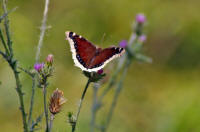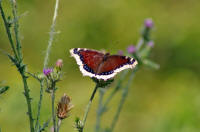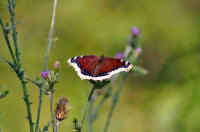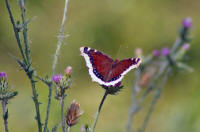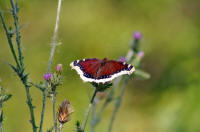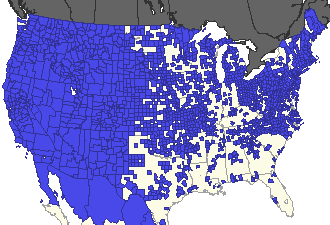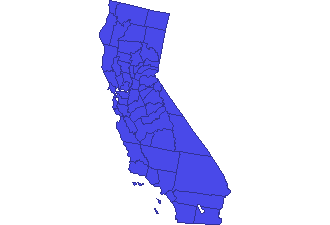|
Taxonomic Hierarchy |
Photo |
|
Kingdom: |
Animalia -- animal |
|
Phylum: |
Arthropoda -- arthropods |
|
Subphylum: |
Hexapoda -- hexapods |
|
Class: |
hexapoda -- insects |
|
Subclass: |
Pterygota -- iwinged insects |
|
Infraclass: |
Neoptera -- modern, wing-folding insects |
|
Order: |
Lepidoptera -- butterflies, moths |
|
Superfamily: |
Papilionoidea -- butterflies |
|
Family: |
Nymphalidae -- admirals, anglewings,
brushfoot butterflies, checker-spots,
crescent-spots, fritillaries, mourningclocks,
purples |
|
Subfamily: |
Nymphalinae |
|
Tribe: |
Nymphalini |
|
Genus: |
Nymphalis |
|
Species: |
Nymphalis antiopa |
|
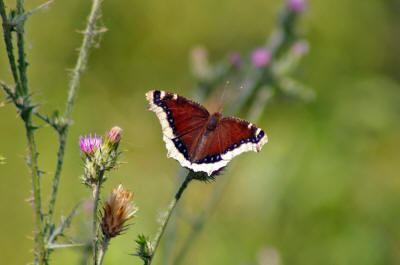 |
|
United States Range Map |
|
California Range Map |
|
|
|
|
|
|
Identification: |
|
Life history:
|
|
Short projections on both wings, borders irregular.
Upperside is purple-black with a wide, bright yellow border
on outer margins, and a row of iridescent blue spots at the
inner edge of the border. |
|
Overwintered adults mate in the spring, the males
perching in sunny openings during the afternoon to
wait for receptive females. Eggs are laid in groups circling
twigs of the host plant. Caterpillars live in a communal web
and feed together on young leaves, then pupate and emerge as
adults in June or July. After feeding briefly, the adults
estivate until fall, when they re-emerge to feed and store
energy for hibernation. Some adults migrate south in the
fall. |
|
Flight: |
|
Wing Span: |
|
Usually one flight from June-July. |
|
2 1/4 - 4 inches (5.7 - 10.1 cm).
|
|
Caterpillar Hosts: |
|
Adult Food: |
|
Willows including black willow (Salix nigra), weeping willow
(S. babylonica), and silky willow (S. sericea); also
American elm (Ulmus americana), cottonwood (Populus
deltoides), aspen (P. tremuloides), paper birch (Betula
papyrifera), and hackberry (Celtis occidentalis). Older
caterpillars wander about and may be found on plants that
they do not eat. |
|
Mourning Cloaks prefer tree sap, especially that of oaks.
They walk down the trunk to the sap and feed head downward.
They will also feed on rotting fruit, and only occasionally
on flower nectar. |
|
Habitat: |
|
Season: |
|
Because Mourning Cloaks roam and migrate, they are found
almost anywhere that host plants occur including woods,
openings, parks, and suburbs; and especially in riparian
areas. |
|
One of the earliest butterflies seen in spring, due to the
fact that it overwinters as an adult. First-generation
adults emerge in early summer, and estivate until fall, when
they re-emerge.
Larvae present from June to September in the east and
from May to July in the west |
|
Remarks: |
|
Conservation: |
|
Caution: Do not
touch the larva; its spines may cause a stinging sensation
if handled. The pupa of the Mourning Cloak is harmless -
unlike the pupa of tent caterpillars (Malacosoma
species), which may cause an allergic reaction on the skin
if handled by allergy sufferers or individuals with very
sensitive skin. |
|
Not required.
NatureServe Global Status:
G5 - Demonstrably secure globally, though it may be quite
rare in parts of its range, especially at the periphery.
Management needs: Occasionally may be necessary to
control caterpillar damage to shade trees.
|
|
Sources used to
Construct this Page: |
|
|
|
|
|
|
NatureServe is a non-profit conservation
organization. Global ranks indicate the rarity of a species at a
global scale. Species may be fairly common globally but imperiled
locally. Global ranks have the following meaning:
- G1 - Critically Imperiled - At very high risk of extinction
due to extreme rarity (often 5 or fewer populations), very steep
declines, or other factors.
- G2 - Imperiled - At high risk of extinction due to very
restricted range, very few populations (often 20 or fewer),
steep declines, or other factors.
- G3 - Vulnerable - At moderate risk of extinction due to a
restricted range, relatively few populations (often 80 or
fewer), recent and widespread declines, or other factors.
- G4 - Apparently Secure - Uncommon but not rare; some cause
for long-term concern due to declines or other factors.
- G5 - Secure - Common; widespread and abundant.
- * ? or Q = status unknown or uncertain
|

